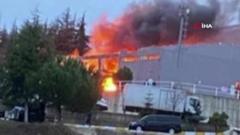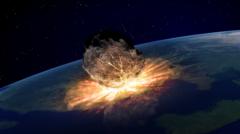On Wednesday, just before dawn, a spectacular fireball briefly lit up the early morning sky near Mexico City, captivating residents and sparking widespread online interest. This brilliant display, identified as a bolide by experts, drew numerous viewers who shared videos of the phenomenon across social media platforms.
Fireball Lights Up the Sky Over Mexico City, Captivating Residents and Online Viewers

Fireball Lights Up the Sky Over Mexico City, Captivating Residents and Online Viewers
A stunning bolide illuminated the skies near Mexico City on Wednesday, sparking excitement both in person and online.
According to the Associated Press, bolides are characterized by their bright explosion in the atmosphere. These phenomena, which can exhibit visible fragmentation, are distinct from meteorites, which reach the Earth's surface. "A bolide is just the luminous phenomenon associated with an object's entry into the atmosphere," explained Jérôme Gattacceca, the editor of The Meteoritical Bulletin, an organization that compiles a database of meteorites.
Dr. Gattacceca highlighted that meteors considered "fireballs" are brighter than the planet Venus. Although meteors and fireballs are frequently observed, bolides are relatively rare, though not entirely uncommon. Guadalupe Cordero Tercero, a researcher at the UNAM Institute of Geophysics, stated in UNAM Global Magazine that an object at least one meter in diameter enters the Earth's atmosphere approximately every two and a half days. Typically, however, these objects go unnoticed as they fall into oceans or uninhabited regions.
Denton Ebel, a meteorite curator at the American Museum of Natural History, expressed his enthusiasm about the potential of the fireball, emphasizing the increased frequency of meteor sightings due to the deployment of fireball networks equipped with cameras.
Reports also noted that the fireball was accompanied by a sonic boom as it broke apart, a phenomenon indicating that meteorites may have reached the ground. The noise can resemble the sound of a freight train, according to Dr. Ebel.
Meteors are formed by space rock collisions with the Earth's atmosphere at remarkable speeds, with most originating from the asteroid belt. Even small rocks can create a dazzling fireball due to their high velocity. Fortunately, Gattacceca reassured the public, stating, "Nobody has ever been killed by a falling meteorite in historical times,” adding that such events pose no danger to the public.
Aimee Ortiz covers breaking news and various topics.
Dr. Gattacceca highlighted that meteors considered "fireballs" are brighter than the planet Venus. Although meteors and fireballs are frequently observed, bolides are relatively rare, though not entirely uncommon. Guadalupe Cordero Tercero, a researcher at the UNAM Institute of Geophysics, stated in UNAM Global Magazine that an object at least one meter in diameter enters the Earth's atmosphere approximately every two and a half days. Typically, however, these objects go unnoticed as they fall into oceans or uninhabited regions.
Denton Ebel, a meteorite curator at the American Museum of Natural History, expressed his enthusiasm about the potential of the fireball, emphasizing the increased frequency of meteor sightings due to the deployment of fireball networks equipped with cameras.
Reports also noted that the fireball was accompanied by a sonic boom as it broke apart, a phenomenon indicating that meteorites may have reached the ground. The noise can resemble the sound of a freight train, according to Dr. Ebel.
Meteors are formed by space rock collisions with the Earth's atmosphere at remarkable speeds, with most originating from the asteroid belt. Even small rocks can create a dazzling fireball due to their high velocity. Fortunately, Gattacceca reassured the public, stating, "Nobody has ever been killed by a falling meteorite in historical times,” adding that such events pose no danger to the public.
Aimee Ortiz covers breaking news and various topics.












